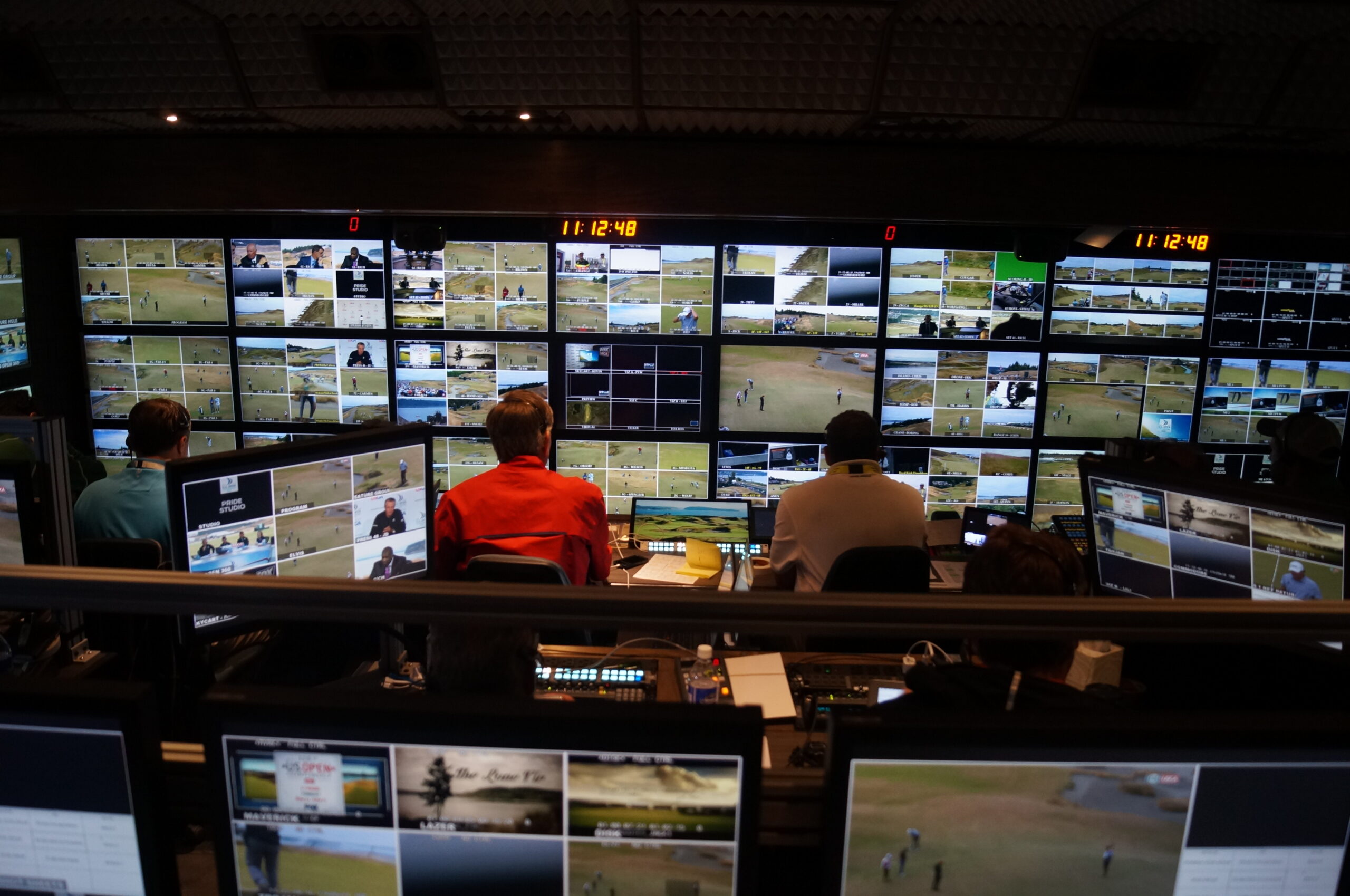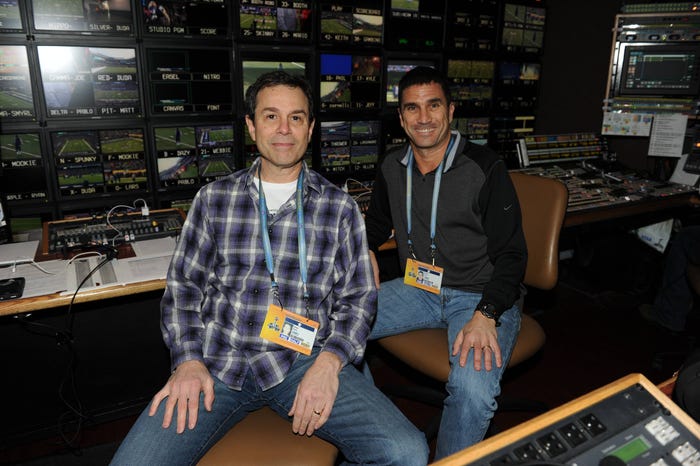Behind The Scenes Of Televised Sports
Hear it here!
For all those out there who watch televised sports of any kind, I wonder if they realize how those pictures appear on screen and who decides what they see?
We take for granted that the action shown will give us the best possible view, including the reaction shots that follow.
I spent my entire TV career either upstairs in a broadcast booth, or in the case of basketball, at a table court side.
But the real action takes place inside a production truck located outside the stadium or arena. That’s where the folks who actually put the broadcast on the air do their thing.
There is a producer, director, technical director, audio man, and countless others in charge of video taping possible replays that follow the live action that is initially shown.
We’re going to only deal with the director here because he is the one man who decides what pictures you see. He’s the one who faces a vast wall of screens showing what each cameraman, (as few as 7 and as many as 20 or so) has focused on, and which one of these shots will be called out to actually go on the air.
It is a lightning fast experience, resembling what sounds very much like an auctioneer does when he’s chanting the rapid change in bids for an item that’s on sale.
If you think about how quickly shots change in any sport that comes to mind, that’s what the activity is in the production truck.
I’ve been blessed working with some of the best ever, and believe me, a good director makes your job so much easier. Here are some of those, who are all in the broadcasting Hall of Fame.
The first one was Harry Coyle, who directed 36 World Series for NBC beginning with the very first one telecast in 1947. He was the man calling the shots for that network’s regular season Game of the Week, as well as nearly 30 All-Star Games.
He was the director, of course, when I joined the NBC team for the 1975 World Series, and is responsible for one of the iconic pictures showing Carlton Fisk using his arms, willing his line drive down the left field line to be a fair ball, and when it was, leaping with joy as he started down the first base line with the game winning home run in the 6th game. As the fortunate one to call that dramatic homer, I know better than anyone that it was the pictures chosen by Harry Coyle that made the moment memorable forever.
The exultation by Fisk was a reaction shot that was taped and shown after the actual home run that people remember. It was Harry Coyle, who decided in advance to place a camera inside the left field scoreboard, enabling the view from left field that made it so special.
A camera inside a scoreboard had never been done before. A true genius of his profession.
Sandy Grossman was a director for CBS Sports for 10 Super Bowls, 18 NBA Finals, five Stanley Cup finals and Olympic events. He won eight Emmy Awards for his directing and was a true innovator.
He was the main man for all of CBS’ NBA coverage, and I had the honor of working with Sandy when I served as lead announcer for the hoops coverage in the early 80’s until NBC took over the contract in 1990.
He was also the lead NFL director and worked with the network’s #1 team of Pat Summerall and John Madden. The connection between Madden and Grossman played, I believe, the major role in Madden’s tremendous success using the telestrator, which were the drawings on-screen that brought out John’s explanation of a play.
Madden also communicated with Sandy via the talk-back button between plays that set up what John wanted to focus on next. The talk back button made it possible for the coach, as he was known, to talk to the director without it going out over the air.
In the hours before a broadcast, and during the pre-game warmups, Grossman instructed his cameramen to be on the lookout for unusual happenings that might be of value, especially if the game became a blowout. Sandy Grossman and John Madden were at work way before the opening kickoff.
Besides never missing a beat in covering an NBA game when I was on the mike, Sandy was the first director to show immediate close-up reaction shots of other players and coaches, as well as the crowd, after a particular play or a key foul.
Grossman also was the first to use music going to a commercial which lent an air of theatrics to a sports telecast.
I miss Sandy, another Hall of Famer, who passed away in 2014.
Still with us is Bob Fishman, another CBS great who just retired in 2022 after becoming the trademark director of the Final Four NCAA Basketball Championship and countless other sports achievements.
He was in the production truck for 39 Final Fours, 27 U.S. Open Tennis tournaments, 21 Daytona 500’s, and other events such as the Belmont Stakes, MLB and NFL Playoffs, and the great figure-skating competition in the Olympics. He also was the director of the NFL Today, the legendary pre-game show in its early years.
Fishman never missed live action on the field of play, not always an easy thing to do, and refined the art of capturing the emotion in every sport he covered.
Do you remember Tonya Harding, in tears, after discovering her laces broke on her skate at the Lillehammer Olympics in 1992?
How about Jim Valvano’s crazy sprint on the floor of the NCAA men’s championship after his N.C. State Wolfpack improbably won the national title in 1983?
To delver further into the list of Bob Fishman’s achievements would be never-ending.
But I recall a personal time. Bob was the director when I teamed up with Jim Kaat for CBS’ backup Baseball Game of the Week. Bob underwent a bone marrow transplant after he was diagnosed with non-Hodgins lymphoma that nearly took his life.
He missed the 1990 Final Four, but in ultra-courageous fashion came back to direct our baseball coverage. Accompanied by his remarkable wife, Margaret, and draped in tubes connecting what it seemed all over his body, I often would fly with them to the site of our game. We would watch the Friday night game before our Saturday afternoon broadcast.
But Bob would retire early to get rest and store up energy for the upcoming telecast.
Those moments are what I remember the most about Bob Fishman.
He will turn 77 at the end of the month.
He’s not yet in the Hall of Fame of directors, but he has plenty of years to go on what has been a terrific career as sports director, Rich Russo just completed his fifth Super Bowl for Fox Sports.
Russo, along with producer Richie Zyontz, finished a season to remember launching the broadcasting career of Tom Brady. Whatever Brady gained in going through his rookie year in the booth, he was blessed working with a duo that excelled in creating the right atmosphere for the super-knowledgeable and uber-intelliegent Brady to make progress. They both got the job done with a remarkable low key and pressure free culture. It is a trademark of Rich Russo as well as the other directors I have saluted.
Russo has learned from the likes of Sandy Grossman and Bob Fishman as others will learn from Rich Russo. Keeping calm and being patient go hand in hand in calling the shots of games that are often frenetic.
All of those revealed here have that trait as they peer over all of the screens and rapidly choose the next picture you see when you watch the games.





